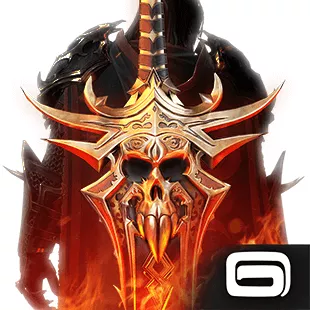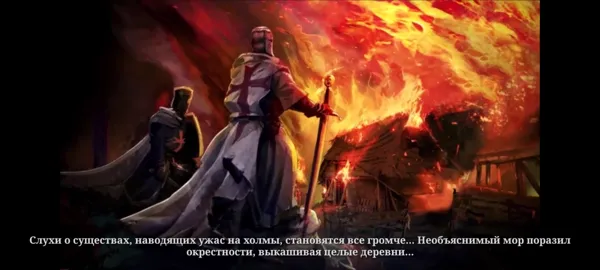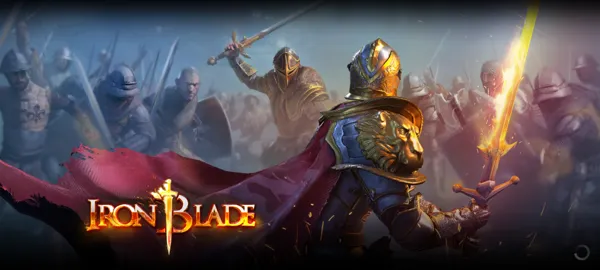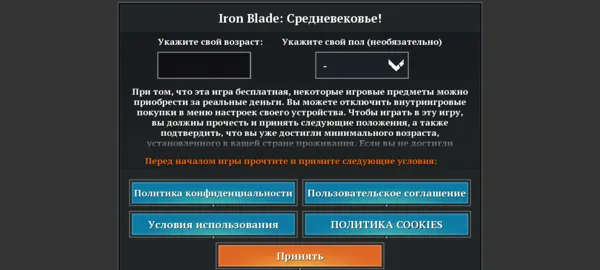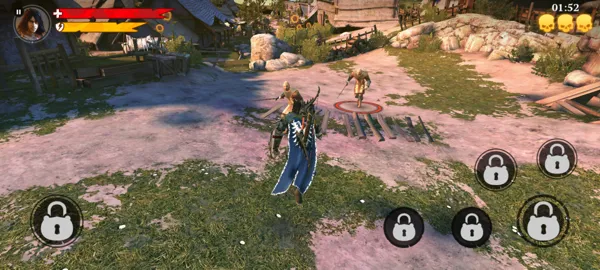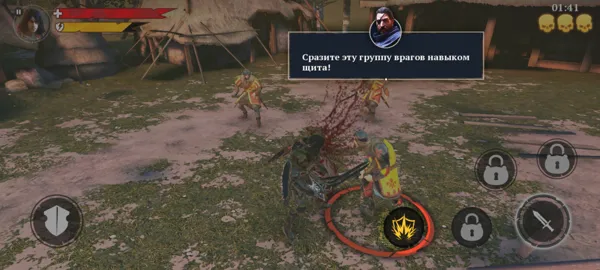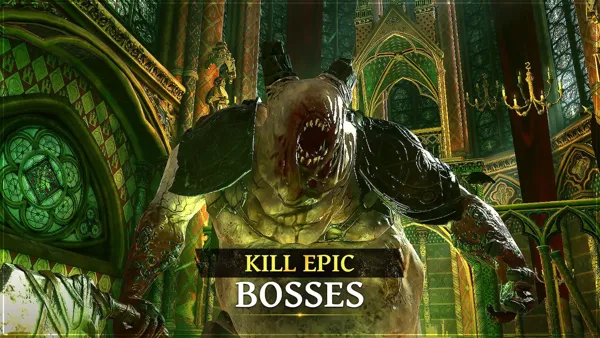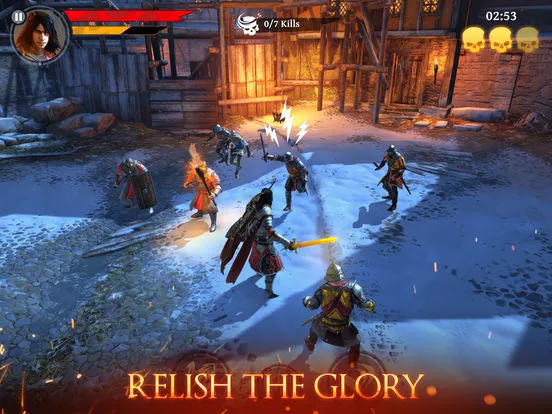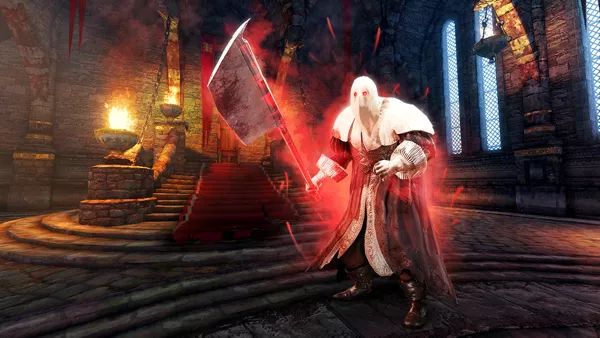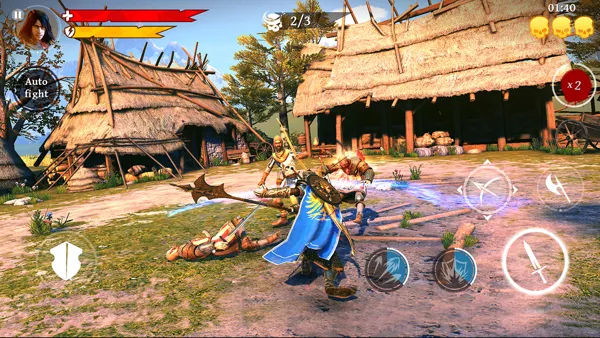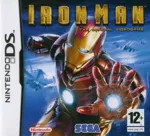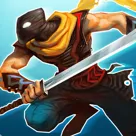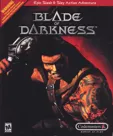Iron Blade
Description official descriptions
The year of our Lord 1307, October, Friday the 13th. By order of King Philip IV the Knights Templar are simultaneously arrested all over France on the charges most foul in nature, major part of which is trafficking with daemons and conspiring with them. Even Jacques de Molay, Master of the Knights Templar, was unable to escape his tragic fate. However, a few knights managed, and among them is Damien, player's character. A young protege of Jacques, he will have to go far and beyond in his efforts to uncover the truth behind the destruction of the Templar Order and to exact his revenge on the masterminds behind it.
Iron Blade is basically a third person action game with some RPG elements mixed in like gaining levels, upgrading gear and using skills that this gear provides. The single player campaign is divided into twelve chapters, and absolute majority of them is split into five levels, the final one being a boss fight. During the course of the campaign, Damien will visit various sites in France, Scotland and Hungary, hunting for clues, equipment and resources. Each level can be replayed countless times, the completion reward heavily dependant on the chosen difficulty level - there's four of them - and on the time it takes a player to defeat all the enemies. Certain aspects and features of the game in both single player and multiplayer modes require specific chapters to be completed as well.
Damien's gear consists of armour proper, helmet, gauntlets and boots for defence. He can do a fast, but weak, main hand attack with his sword, deliver an off-hand blow with a heavy weapon, lob off an arrow from his bow, or use his shield to either defend from an attack, or to stun his enemies. Each gear element comes in four rarities and can further be upgraded in nine tiers, each upgrade costing progressively more resources, and advancing a tier on some item requires hours of grinding more often than not. Also each gear element provides the protagonist with ether a passive or an active ability, the latter known as skills, which could be used in combat with a short cooldown period. Some items can be put together to make a set, with every two items from a set activating a certain additional bonus, and all of them come in the Demonic, Heroic and Divine alignments. The player has to keep an eye on that variety to pick the proper items to defeat various human, undead and demonic opponents, with them getting more and more stronger with both game progression and difficulty growth.
Beside the single player campaign, Iron Blade has several kinds of activities like gauntlets, daily challenges, boss hunts, alliances competitions and leader-board ratings with weekly rewards. There's no multiplayer PvP in classical meaning, though. Instead the players raid each other's strongholds. The goal of attacker is to defeat up to three waves of troops which could be garrisoned in a player's citadel. If successful, the player gains ratings and spoils. If not - the defending party gets a rating boost. The players having any control only when they are attacking somebody's fort. Defence happens in complete background without any input possible. The troops can be upgraded and advanced in their tiers as well.
Finally, there is a shop that is full of various power-ups, including the energy, which is necessary to perform any single player or multiplayer action, and which can only be restored via the purchase, challenge completion or waiting for some real time to pass. There's also an option to convert some real world money into the in-game rubies, which can be then used to purchase the strongest power-ups or items.
Groups +
Screenshots
Promos
Videos
Add Trailer or Gameplay Video +1 point
See any errors or missing info for this game?
You can submit a correction, contribute trivia, add to a game group, add a related site or alternate title.
Credits (Android version)
609 People (607 developers, 2 thanks) · View all
| HQ Producers | |
| Senior Producer | |
| Producers | |
| Lead Designers | |
| Designers | |
| Game Economy Designers | |
| Lead Programmers | |
| [ full credits ] | |
Reviews
Critics
Players
Average score: 2.2 out of 5 (based on 4 ratings with 2 reviews)
Here's farming, there's grind, grind, grind...
The Good
First of all, I'd like to say that I've had the opportunity to play Iron Blade both on PC and on my Samsung, so this review is for both platforms at once, but it's slightly more PC slanted, because of it being my primary gaming platform.
The visuals in Iron Blade are nothing to write home about, but they are not terrible either. The palette and the art style are fitting the theme chosen for the game, and both the bright, vibrant rural sceneries, changing onto the dark, damp castles and crypts do their job of submerging the user into a Medieval low-fantasy setting. When played on a smartphone, with its small screen, the provided visuals of the picture are good enough to be pleasing to the eye, and a good balance between the render quality and power demands were achieved for the game to perform fast and smooth, what is, in fact, crucial for a hack’n’slash title. I did play a few mobile games that were slanted more toward the graphics quality, and, when the screen was full of action, my phone weren't shy from becoming a hand warming device and sucking its battery dry and empty, no matter if I played a space 4X or a base building simulator. However, from a PC gamer's point of view, the graphics is quite aged for a 2019 release. However, it is not that bad to become appalling, and, considering the PC version is a direct port of the mobile game, it is tolerable.
Sound effects in Iron Blade are sooner a good thing. Every single line of dialogue in the cutscenes is said out loud, and every single enemy the player encounters has a number of taunts, threats and banter lines recorded for them. The sound effects accompanying all the attacks and actions like skill usage are also varied, not becoming repetitive enough to annoy the player out. A spoon of dirt would be the menu sounds, which could get old quite fast. Yet again, comparing this game to quite a few similar releases, I found myself pleasantly surprised by the amount of voice over Iron Blade got. It was not uncommon to see barely a few lines spoken out loud, and the most of the presentation done via plain text inside of a game with a huge advertising and marketing campaign that had a daily number of active players larger than the total player amount Iron Blade had ever attained.
Once again, I'm on the fence about the overall vibe and the setting of the game. I can't even decide for myself, for example, whether this is a high-fantasy or low-fantasy world. There are some serious historical references, but, at the same time, there are supernatural powers in effect, so that reflects on the events playing out in and around the really existent European locations. And the game is set only in the real-world locations, some of which are reconstructed on screen with maximum detail, even if the most served just as a loose base. Let's just mention here that it is not very often when the game designers take our real world, albeit in a different era, and cross-breed it with the fantasy and folklore elements quite subtly. I can hardly remember more than three titles that would do the same off the top of my head. It's usually either a rough foundation upon which a world similar to ours is built, sometimes even without any kind of magic, or it's a heavy modification of our own. Then again, Knights Templar being a real Medieval order, the authors didn't have too many options. And, while we at it, the credit is gotta be given where it is due - they surely did their homework on history. Some temporal discrepancies are present, of course, but the Templar Conspiracy itself was exploited to the maximum, all the obscure, hardly mentioned characters getting at least a honorary mention.
Granted, it wouldn't be neither the very first, nor the very last game ever released to dwell on the theme of Knights Templar and their demise, along with all the surrounding conspiracy. I've seen a lot of movies and series, and played a few games on the topic. Iron Blade isn't the first game either to show that some kind of a demonic conspiracy did truly exist and served as the main driver behind the events unfolding on screen, but I believe it differs from the most in the way where did that conspiracy grew its roots. In this world we learn that the Templars are, indeed, corrupt. That there's a huge demonic influence over them. And that it was one of their leaders that convinced King Philip IV to crash down on the Templar leadership and the knights still loyal to the old ways. Why? It's for the player to find out the answers, piecing together a clue after a clue and to finally understand how the demons, Templars, King and Cathars are all tied off in one dreadful knot. By the way, I believe that involving the Cathars in the plot was an actual novelty when the game released.
And writing behind all that was done sturdy enough. It is not brilliant, some of the plot twists are easily predicted, but it isn't full of gaping holes either. Dialogues are a bit flat, and some are clearly written as fillers to justify the need for yet another stage to be hacked through, though. Oh, and while there are animated cutscenes, about three quarters of the presentation are given through still images with the lines of text on them being spoken by the actors. Once again, if we are to consider the game being a mobile slasher first of all, and only after that a port to PC platform, then it's all explainable.
The Bad
While the sound effects are sooner in the positive bin, the musical score goes straight into the bad one. Iron Blade is plagued with the same disease that hit most of the similar releases - there is just a handful of tracks, like one per situation, maybe two for combat, and they're becoming annoyingly repetitive and looped extremely fast. Especially so because, unlike the sound effects which vary and are not always in your speakers, the musical tracks are always heard. I do realise that there can be only so much tracks written for any game there is, but somehow I usually don't grind my teeth as I navigate into the options menu to completely mute the background music. Most of the time I do enjoy the OST, even if the songs do repeat themselves, because it actually serves to set the mood, to accentuate and to shape the experience, instead of sticking out like a sore thumb and drawing your attention to it instead of subtly underling the action on screen like we have it in the Iron Blade.
And now the time has come to move into the gameplay review, and that's where I'm going to rant, and a lot. My first problem with Iron Blade is that its main genre is defined as an RPG. Okay. It was released in 2019, and it's now the end of 2023 when I'm writing this review, and I've witnessed the gaming genres coming and going before my eyes as I grew up and live, and I'm fully aware of the current situation when it's quite hard to dump a game into a specific category, because nowadays a lot of the classical ones have merged and blended into a mix of sorts. But, please. Iron Blade is not an RPG in its classical sense. Even MobyGames defines the genre with the focus on character development first and foremost, along with amassing wealth, and gradual increase of power through collecting gear or utilities. I can't deny all those elements being present in Iron Blade, but, at least in my mind, a role-playing game assumes that the players have an ability to spec the character however they want, and then gradually explore the world of those characters in whatever way they see fit, instead of being led along the rails, with no wobble to the left or right allowed.
Now take Iron Blade. Here we have strictly predefined order of levels to be completed in the campaign, and the veering to a side could be done only in the form of multiplayer or various bonus activities. As for the RPG staple that some do call "spreadsheet simulator", our protagonist Damien has only two stats - his health and his stamina, which get a flat increase every time there's enough XP to level up. Oh, yes, experience meter is also present, how could I have forgotten about it? Yes, there is also a lot of focus on upgrading your gear. But instead of quietly picking the pockets and removing the boots from the still bodies of your fresh kills, you get a random reward at the end of each stage that depends on the time it took you to complete a level, and on the difficulty rating.
Another RPG staple is character creation process that migrated these days in many other genres, including strategies even. In Iron Blade we can only give ourselves as players a unique name to identify ourselves from the crowd. The character we play would always stay the same. Always. In all aspects, his name included. Okay, once again, it was historically nigh impossible to see a female warrior in the Medieval Europe, but there were some, however a rarity they were. And, being historically accurate, it was really impossible to see a female member of a knightly order. However, even the game itself presents us with a couple of female fighters to accompany us in the campaign. But we can't customise even the beard on our character. Once again, the game was released in 2019 initially, so lack of the proper character creation inside of an RPG is very weird.
Bottom line for this here item on the list would be that I'd sooner call it an Action game, with addition of some RPG elements.
Next, Iron Blade was the very first game I played that had this "energy" concept that I've never encountered before. And I played it mostly on PC, so it was double surprising to see it there. For those as unfamiliar with it as I was, it means that you, as a player, have a certain amount of energy points, and each level completion or activity costs energy to do. For example, completing the very first stage of the campaign costs about two energy units, but trying to do it on highest difficulty for the juiciest rewards would cost already eight, and it goes progressively up as the player goes through the main story. Additional activities that the game has also require the energy to be spent. Ran out of energy? Wait for the 25 hours of real time for it to be restored fully, or check if any of your daily challenges or side missions brought you reward in the form of the energy, locked inside one of the many reward chests. If there was none, than there is always the in-game shop, where you can buy some for the in-game currency. Don't have the war tokens, gold or rubies? Well, there's the special page in the in-game shop that allows you to convert the real world money into them... You get the idea. Okay, I understand that this feature is meant to nudge players to spend the real money so Gameloft could make some profit, but for someone like it me was plain frustrating.
The next item on the dislike list would be the fact that I can't control Damien beside choosing what attack would he deliver when I'd press a button. Each level is divided into several fighting sections, where the camera angle is basically set to remain the same, hardly turning left or right unless absolutely necessary, and the player lacks even basic movement controls over the protagonist. You can't even lock on a specific enemy, and keep hitting the one that attacked you the last. The only choice is whether to keep chaining light attacks, or deliver a heavy one, or a nearly useless ranged one. There's also blocking, which becomes quite ineffective after Damien runs out of his stamina, what might happen quite fast on high difficulty levels, and there are active skills, but the pair of them on screen is chosen randomly, and you can't use another until at least one of those was, and the new one will also be chosen randomly. What skills you have available depends on your gear. Speaking of which, at one point in the game it becomes obvious that you can't progress further until you have better, or, in the very least, upgraded one, and it forces you as the player to repeat the stages and challenges you've already done, over and over again, once again spending the energy, praying to the RNG to deliver you something nice finally.
Another weird thing that I disliked a lot was the way multiplayer is organized in the game. First of all, it is not available until you complete at least two campaign chapters. And, you guessed it right, it also needs energy to be played. Good job it's the different kind of energy meter, and that's actually one of the two resources you'd never notice running out, because any multiplayer action, including some activities, costs exactly one multiplayer energy point. But I digress. The MP concept for such kind of a game is very unusual, in my opinion, but I guess it stems from the fact that every player controls exactly the same character. After completing chapter two, you get access to a fort. The troop cards that are among the rewards can be used to garrison it, making in total three waves with a leader in charge, the leader being one of the campaign bosses. Just as with the equipment, these troops can be upgraded to become stronger and provide better defences.
The idea is that you are randomly matched with some other player, and if you choose to attack, then you have to single-handedly defeat the fortress garrison (which would instantly respawn in any case after the fight concludes). If you are successful, then you loot all the gold and rubies the opponent had accumulated in his fortress and had no chance of "harvesting" to be added to his stock before the attack. You also get a boost to your multiplayer rating. If you are defeated by the garrison, then you just wasted your energy, and your rating drops, and opponent's grows. There are ten leagues in the ranking board, with seven of them being time independent, and the last three requiring you climbing the ranks every week, because they provide the fattest rewards. It goes without the saying that higher you are up the ranking, the tougher are the opponents. But, if you have at least some semblance of action and control when attacking another player, you have absolutely no saying about the defences. You just get a message, informing you whether you got a boost to your rankings, or you got knocked down a few pegs. And woe upon you if you attack some overly sensitive player or an alliance, the members of which are full of themselves. Beside the flak you'll get in the chat, you'll also have every member of that alliance trying to attack your fortress the moment they can. It's not uncommon to read the pages of apologies for the newbie players in the main, spilling the words in attempt to prove they were attacking someone just because the campaign demanded them to as to unlock the multiplayer features, and not because they had some malicious intent behind it.
Also while speaking about the equipment it is impossible to avoid tying it up with the difficulty system. I've already mentioned above that the loot you gain upon the completion of a level or activity, or when opening a reward chest is completely random, and that the higher is the difficulty the richer are the rewards. The thing is that these four difficulty levels are very non-linear in their scaling, and, while it is quite easy to complete the game like a breeze on the lowest setting, even the next step up requires a lot of time and resource investments, and there are two more to reach the desired 100% achievement (which alone grants huge rewards). At some point, even the very first level gets populated with the enemies that were supposed to appear much later in the campaign, effectively rendering the characters idiotic when they discuss those much later as first ever encountered vampires, for example, while you were slaughtering them left, right and centre for the previous four chapters already. Especially evil are the last two chapters, which were added as a part of a later update to the game, and as such they are designed for the veterans in the first place, being able to knock the player back on the ass even on the easiest setting if you are not careful. Thus a vicious circle forms: to gain better equipment, you have to complete the stages on tougher settings, but, to do that, you need better equipment. And so the grind begins, when the same level is completed over and over again in hopes that the dreadful god of RNG would yield something desirable at final last. There is an option to skip the actual gameplay and just get the random loot, but it is only available if you've beaten this specific level on the current difficulty setting with the timer not reaching zero and going down a peg. Needless to say that even skipping a level also costs energy and items.
The game is fast to teach you how to upgrade your gear, but soon enough you find out that all the effort and resource you have put into upgrading your basic sword and armour did you good for a while, but it's a complete waste for the tougher settings, because you need to first hunt for the legendary items, quickly turning to discard all the common, rare and even epic ones. Then you are fast to learn that each item can be upgraded nine tiers, and if the first five require just gold and experience (which is gained from fusing the other items with it, or looting and buying special XP cards), evolution between the tier five and the next one, and so forth, requires some godawful amount of truly rare resources, which are extremely hard to come by. And after that you eventually find out that the Divine - Demonic - Heroic system of every item and every creature in the game is not just akin to Rock - Paper - Scissors, but it becomes crucial eventually. Each campaign chapter is themed under an element, and while at first it doesn't matter, then it becomes obvious that you need to have the gear equipped that is comprised of the items with the opposing element, or you just won't be able to complete the stage. So you basically need to spend countless hours grinding to get three different elemental sets in the best possible quality. And of course it still won't be enough, because you need to have sets of the specific items, which worn together give you rare boosts that could be a game changer, and being part of an active alliance gives boosts as well to your attack and defence ratings. In fact, it seems to be impossible to hundred percent the campaign without being a member of a clan and without investing real money, or a few years of your time, making Iron Blade your day job. At least they included auto-play feature for situations like that, so the game could play itself for a while. And some upgrades, like skill boosters for the items, can't be looted, they can only be purchased in shop for completing multiplayer activities with enough tokens to allow that. So, it's grind, grind, grind... Endless grind.
So the game is indeed easy to learn, as the ad blurbs state, but I wouldn't say that it's hard to master, it's time-consuming to climb up to the top. And if a mistake in picking the wrong gear to approach a campaign level would just result in a waste of resource and time, I can see how the MP challenges, where all the enemies are a mix of elements and types, easily can frustrate players enough to invest real money to get some payback. I am proud to say that I've managed to avoid spending a single cent on that.
The final rant section will be about the interface. The very first note that needs to be made is that the game was designed as a mobile one, so it handles way better on a smartphone than on computer in some aspects, but it still is not that good. Yes, it is, on one hand, comfortable enough to control the attacks and skills with two thumbs only, but when the situation calls for a rapid action, sometimes it's very easy to slide the screen in another direction or just mistap. Adaptation of these control schematics to the PC port made the game behave erratically and nigh impossibility of properly applying the directed skills, because it often seems to ignore the desperate mouse movement. As for the attacks themselves, it is easier to use the keyboard controls than clicking the mouse buttons. Also I wonder how many people actually tapped the screen when offered, because there is absolutely no difference in the text between the mobile and PC versions of the game.
Next interface problem is once again connected to the inability to control your character. Damien can't be made to walk or run on your demand, he can either cover distance with another enemy, or run between the preset locations for yet another fight. So, you sometimes might end up stuck, unable even to turn to kill the last enemy that is using ranged or magical attacks to hurt you, and there are only options to either die and restart, or rage quit and restart. The final chapter is also full of graphical bugs, at least prominent on PC, which would either fix camera under some awkward angle, or just black out, preventing you from see any opposition, and this is crucial to employ some skills or to deflect a blow.
I'm pretty sure there were more little things that were annoying, but I'd better wrap it up already.
The Bottom Line
All in all, unless I'm just an old millennial that got stuck back in her Fallout 2, Morrowind, or Baldur's Gate, and my ideas about what is an RPG are obsolete already, I'd recommend giving Iron Blade a wide berth. Of course, if you do happen to like the games like this one, or just are a hardcore Templar fan, who wants to see yet another story about them, then sure, give it a go. Just keep in mind that Gameloft seems to have discontinued all but legacy support of this game. There was no fresh patch for a few years, and I believe it has been removed from Steam catalogue as well, at least there was a huge warning notice about it nearly a year and half ago when starting the client, but I'm actually unsure about it.
Windows · by Vereina (787) · 2023
Here's farming, there's grind, grind, grind...
The Good
First of all, I'd like to say that I've had the opportunity to play Iron Blade both on PC and on my Samsung, so this review is for both platforms at once, but it's slightly more PC slanted, because of it being my primary gaming platform.
The visuals in Iron Blade are nothing to write home about, but they are not terrible either. The palette and the art style are fitting the theme chosen for the game, and both the bright, vibrant rural sceneries, changing onto the dark, damp castles and crypts do their job of submerging the user into a Medieval low-fantasy setting. When played on a smartphone, with its small screen, the provided visuals of the picture are good enough to be pleasing to the eye, and a good balance between the render quality and power demands were achieved for the game to perform fast and smooth, what is, in fact, crucial for a hack’n’slash title. I did play a few mobile games that were slanted more toward the graphics quality, and, when the screen was full of action, my phone weren't shy from becoming a hand warming device and sucking its battery dry and empty, no matter if I played a space 4X or a base building simulator. However, from a PC gamer's point of view, the graphics is quite aged for a 2019 release. However, it is not that bad to become appalling, and, considering the PC version is a direct port of the mobile game, it is tolerable.
Sound effects in Iron Blade are sooner a good thing. Every single line of dialogue in the cutscenes is said out loud, and every single enemy the player encounters has a number of taunts, threats and banter lines recorded for them. The sound effects accompanying all the attacks and actions like skill usage are also varied, not becoming repetitive enough to annoy the player out. A spoon of dirt would be the menu sounds, which could get old quite fast. Yet again, comparing this game to quite a few similar releases, I found myself pleasantly surprised by the amount of voice over Iron Blade got. It was not uncommon to see barely a few lines spoken out loud, and the most of the presentation done via plain text inside of a game with a huge advertising and marketing campaign that had a daily number of active players larger than the total player amount Iron Blade had ever attained.
Once again, I'm on the fence about the overall vibe and the setting of the game. I can't even decide for myself, for example, whether this is a high-fantasy or low-fantasy world. There are some serious historical references, but, at the same time, there are supernatural powers in effect, so that reflects on the events playing out in and around the really existent European locations. And the game is set only in the real-world locations, some of which are reconstructed on screen with maximum detail, even if the most served just as a loose base. Let's just mention here that it is not very often when the game designers take our real world, albeit in a different era, and cross-breed it with the fantasy and folklore elements quite subtly. I can hardly remember more than three titles that would do the same off the top of my head. It's usually either a rough foundation upon which a world similar to ours is built, sometimes even without any kind of magic, or it's a heavy modification of our own. Then again, Knights Templar being a real Medieval order, the authors didn't have too many options. And, while we at it, the credit is gotta be given where it is due - they surely did their homework on history. Some temporal discrepancies are present, of course, but the Templar Conspiracy itself was exploited to the maximum, all the obscure, hardly mentioned characters getting at least a honorary mention.
Granted, it wouldn't be neither the very first, nor the very last game ever released to dwell on the theme of Knights Templar and their demise, along with all the surrounding conspiracy. I've seen a lot of movies and series, and played a few games on the topic. Iron Blade isn't the first game either to show that some kind of a demonic conspiracy did truly exist and served as the main driver behind the events unfolding on screen, but I believe it differs from the most in the way where did that conspiracy grew its roots. In this world we learn that the Templars are, indeed, corrupt. That there's a huge demonic influence over them. And that it was one of their leaders that convinced King Philip IV to crash down on the Templar leadership and the knights still loyal to the old ways. Why? It's for the player to find out the answers, piecing together a clue after a clue and to finally understand how the demons, Templars, King and Cathars are all tied off in one dreadful knot. By the way, I believe that involving the Cathars in the plot was an actual novelty when the game released.
And writing behind all that was done sturdy enough. It is not brilliant, some of the plot twists are easily predicted, but it isn't full of gaping holes either. Dialogues are a bit flat, and some are clearly written as fillers to justify the need for yet another stage to be hacked through, though. Oh, and while there are animated cutscenes, about three quarters of the presentation are given through still images with the lines of text on them being spoken by the actors. Once again, if we are to consider the game being a mobile slasher first of all, and only after that a port to PC platform, then it's all explainable.
The Bad
While the sound effects are sooner in the positive bin, the musical score goes straight into the bad one. Iron Blade is plagued with the same disease that hit most of the similar releases - there is just a handful of tracks, like one per situation, maybe two for combat, and they're becoming annoyingly repetitive and looped extremely fast. Especially so because, unlike the sound effects which vary and are not always in your speakers, the musical tracks are always heard. I do realise that there can be only so much tracks written for any game there is, but somehow I usually don't grind my teeth as I navigate into the options menu to completely mute the background music. Most of the time I do enjoy the OST, even if the songs do repeat themselves, because it actually serves to set the mood, to accentuate and to shape the experience, instead of sticking out like a sore thumb and drawing your attention to it instead of subtly underling the action on screen like we have it in the Iron Blade.
And now the time has come to move into the gameplay review, and that's where I'm going to rant, and a lot. My first problem with Iron Blade is that its main genre is defined as an RPG. Okay. It was released in 2019, and it's now the end of 2023 when I'm writing this review, and I've witnessed the gaming genres coming and going before my eyes as I grew up and live, and I'm fully aware of the current situation when it's quite hard to dump a game into a specific category, because nowadays a lot of the classical ones have merged and blended into a mix of sorts. But, please. Iron Blade is not an RPG in its classical sense. Even MobyGames defines the genre with the focus on character development first and foremost, along with amassing wealth, and gradual increase of power through collecting gear or utilities. I can't deny all those elements being present in Iron Blade, but, at least in my mind, a role-playing game assumes that the players have an ability to spec the character however they want, and then gradually explore the world of those characters in whatever way they see fit, instead of being led along the rails, with no wobble to the left or right allowed.
Now take Iron Blade. Here we have strictly predefined order of levels to be completed in the campaign, and the veering to a side could be done only in the form of multiplayer or various bonus activities. As for the RPG staple that some do call "spreadsheet simulator", our protagonist Damien has only two stats - his health and his stamina, which get a flat increase every time there's enough XP to level up. Oh, yes, experience meter is also present, how could I have forgotten about it? Yes, there is also a lot of focus on upgrading your gear. But instead of quietly picking the pockets and removing the boots from the still bodies of your fresh kills, you get a random reward at the end of each stage that depends on the time it took you to complete a level, and on the difficulty rating.
Another RPG staple is character creation process that migrated these days in many other genres, including strategies even. In Iron Blade we can only give ourselves as players a unique name to identify ourselves from the crowd. The character we play would always stay the same. Always. In all aspects, his name included. Okay, once again, it was historically nigh impossible to see a female warrior in the Medieval Europe, but there were some, however a rarity they were. And, being historically accurate, it was really impossible to see a female member of a knightly order. However, even the game itself presents us with a couple of female fighters to accompany us in the campaign. But we can't customise even the beard on our character. Once again, the game was released in 2019 initially, so lack of the proper character creation inside of an RPG is very weird.
Bottom line for this here item on the list would be that I'd sooner call it an Action game, with addition of some RPG elements.
Next, Iron Blade was the very first game I played that had this "energy" concept that I've never encountered before. And I played it mostly on PC, so it was double surprising to see it there. For those as unfamiliar with it as I was, it means that you, as a player, have a certain amount of energy points, and each level completion or activity costs energy to do. For example, completing the very first stage of the campaign costs about two energy units, but trying to do it on highest difficulty for the juiciest rewards would cost already eight, and it goes progressively up as the player goes through the main story. Additional activities that the game has also require the energy to be spent. Ran out of energy? Wait for the 25 hours of real time for it to be restored fully, or check if any of your daily challenges or side missions brought you reward in the form of the energy, locked inside one of the many reward chests. If there was none, than there is always the in-game shop, where you can buy some for the in-game currency. Don't have the war tokens, gold or rubies? Well, there's the special page in the in-game shop that allows you to convert the real world money into them... You get the idea. Okay, I understand that this feature is meant to nudge players to spend the real money so Gameloft could make some profit, but for someone like it me was plain frustrating.
The next item on the dislike list would be the fact that I can't control Damien beside choosing what attack would he deliver when I'd press a button. Each level is divided into several fighting sections, where the camera angle is basically set to remain the same, hardly turning left or right unless absolutely necessary, and the player lacks even basic movement controls over the protagonist. You can't even lock on a specific enemy, and keep hitting the one that attacked you the last. The only choice is whether to keep chaining light attacks, or deliver a heavy one, or a nearly useless ranged one. There's also blocking, which becomes quite ineffective after Damien runs out of his stamina, what might happen quite fast on high difficulty levels, and there are active skills, but the pair of them on screen is chosen randomly, and you can't use another until at least one of those was, and the new one will also be chosen randomly. What skills you have available depends on your gear. Speaking of which, at one point in the game it becomes obvious that you can't progress further until you have better, or, in the very least, upgraded one, and it forces you as the player to repeat the stages and challenges you've already done, over and over again, once again spending the energy, praying to the RNG to deliver you something nice finally.
Another weird thing that I disliked a lot was the way multiplayer is organized in the game. First of all, it is not available until you complete at least two campaign chapters. And, you guessed it right, it also needs energy to be played. Good job it's the different kind of energy meter, and that's actually one of the two resources you'd never notice running out, because any multiplayer action, including some activities, costs exactly one multiplayer energy point. But I digress. The MP concept for such kind of a game is very unusual, in my opinion, but I guess it stems from the fact that every player controls exactly the same character. After completing chapter two, you get access to a fort. The troop cards that are among the rewards can be used to garrison it, making in total three waves with a leader in charge, the leader being one of the campaign bosses. Just as with the equipment, these troops can be upgraded to become stronger and provide better defences.
The idea is that you are randomly matched with some other player, and if you choose to attack, then you have to single-handedly defeat the fortress garrison (which would instantly respawn in any case after the fight concludes). If you are successful, then you loot all the gold and rubies the opponent had accumulated in his fortress and had no chance of "harvesting" to be added to his stock before the attack. You also get a boost to your multiplayer rating. If you are defeated by the garrison, then you just wasted your energy, and your rating drops, and opponent's grows. There are ten leagues in the ranking board, with seven of them being time independent, and the last three requiring you climbing the ranks every week, because they provide the fattest rewards. It goes without the saying that higher you are up the ranking, the tougher are the opponents. But, if you have at least some semblance of action and control when attacking another player, you have absolutely no saying about the defences. You just get a message, informing you whether you got a boost to your rankings, or you got knocked down a few pegs. And woe upon you if you attack some overly sensitive player or an alliance, the members of which are full of themselves. Beside the flak you'll get in the chat, you'll also have every member of that alliance trying to attack your fortress the moment they can. It's not uncommon to read the pages of apologies for the newbie players in the main, spilling the words in attempt to prove they were attacking someone just because the campaign demanded them to as to unlock the multiplayer features, and not because they had some malicious intent behind it.
Also while speaking about the equipment it is impossible to avoid tying it up with the difficulty system. I've already mentioned above that the loot you gain upon the completion of a level or activity, or when opening a reward chest is completely random, and that the higher is the difficulty the richer are the rewards. The thing is that these four difficulty levels are very non-linear in their scaling, and, while it is quite easy to complete the game like a breeze on the lowest setting, even the next step up requires a lot of time and resource investments, and there are two more to reach the desired 100% achievement (which alone grants huge rewards). At some point, even the very first level gets populated with the enemies that were supposed to appear much later in the campaign, effectively rendering the characters idiotic when they discuss those much later as first ever encountered vampires, for example, while you were slaughtering them left, right and centre for the previous four chapters already. Especially evil are the last two chapters, which were added as a part of a later update to the game, and as such they are designed for the veterans in the first place, being able to knock the player back on the ass even on the easiest setting if you are not careful. Thus a vicious circle forms: to gain better equipment, you have to complete the stages on tougher settings, but, to do that, you need better equipment. And so the grind begins, when the same level is completed over and over again in hopes that the dreadful god of RNG would yield something desirable at final last. There is an option to skip the actual gameplay and just get the random loot, but it is only available if you've beaten this specific level on the current difficulty setting with the timer not reaching zero and going down a peg. Needless to say that even skipping a level also costs energy and items.
The game is fast to teach you how to upgrade your gear, but soon enough you find out that all the effort and resource you have put into upgrading your basic sword and armour did you good for a while, but it's a complete waste for the tougher settings, because you need to first hunt for the legendary items, quickly turning to discard all the common, rare and even epic ones. Then you are fast to learn that each item can be upgraded nine tiers, and if the first five require just gold and experience (which is gained from fusing the other items with it, or looting and buying special XP cards), evolution between the tier five and the next one, and so forth, requires some godawful amount of truly rare resources, which are extremely hard to come by. And after that you eventually find out that the Divine - Demonic - Heroic system of every item and every creature in the game is not just akin to Rock - Paper - Scissors, but it becomes crucial eventually. Each campaign chapter is themed under an element, and while at first it doesn't matter, then it becomes obvious that you need to have the gear equipped that is comprised of the items with the opposing element, or you just won't be able to complete the stage. So you basically need to spend countless hours grinding to get three different elemental sets in the best possible quality. And of course it still won't be enough, because you need to have sets of the specific items, which worn together give you rare boosts that could be a game changer, and being part of an active alliance gives boosts as well to your attack and defence ratings. In fact, it seems to be impossible to hundred percent the campaign without being a member of a clan and without investing real money, or a few years of your time, making Iron Blade your day job. At least they included auto-play feature for situations like that, so the game could play itself for a while. And some upgrades, like skill boosters for the items, can't be looted, they can only be purchased in shop for completing multiplayer activities with enough tokens to allow that. So, it's grind, grind, grind... Endless grind.
So the game is indeed easy to learn, as the ad blurbs state, but I wouldn't say that it's hard to master, it's time-consuming to climb up to the top. And if a mistake in picking the wrong gear to approach a campaign level would just result in a waste of resource and time, I can see how the MP challenges, where all the enemies are a mix of elements and types, easily can frustrate players enough to invest real money to get some payback. I am proud to say that I've managed to avoid spending a single cent on that.
The final rant section will be about the interface. The very first note that needs to be made is that the game was designed as a mobile one, so it handles way better on a smartphone than on computer in some aspects, but it still is not that good. Yes, it is, on one hand, comfortable enough to control the attacks and skills with two thumbs only, but when the situation calls for a rapid action, sometimes it's very easy to slide the screen in another direction or just mistap. Adaptation of these control schematics to the PC port made the game behave erratically and nigh impossibility of properly applying the directed skills, because it often seems to ignore the desperate mouse movement. As for the attacks themselves, it is easier to use the keyboard controls than clicking the mouse buttons. Also I wonder how many people actually tapped the screen when offered, because there is absolutely no difference in the text between the mobile and PC versions of the game.
Next interface problem is once again connected to the inability to control your character. Damien can't be made to walk or run on your demand, he can either cover distance with another enemy, or run between the preset locations for yet another fight. So, you sometimes might end up stuck, unable even to turn to kill the last enemy that is using ranged or magical attacks to hurt you, and there are only options to either die and restart, or rage quit and restart. The final chapter is also full of graphical bugs, at least prominent on PC, which would either fix camera under some awkward angle, or just black out, preventing you from see any opposition, and this is crucial to employ some skills or to deflect a blow.
I'm pretty sure there were more little things that were annoying, but I'd better wrap it up already.
The Bottom Line
All in all, unless I'm just an old millennial that got stuck back in her Fallout 2, Morrowind, or Baldur's Gate, and my ideas about what is an RPG are obsolete already, I'd recommend giving Iron Blade a wide berth. Of course, if you do happen to like the games like this one, or just are a hardcore Templar fan, who wants to see yet another story about them, then sure, give it a go. Just keep in mind that Gameloft seems to have discontinued all but legacy support of this game. There was no fresh patch for a few years, and I believe it has been removed from Steam catalogue as well, at least there was a huge warning notice about it nearly a year and half ago when starting the client, but I'm actually unsure about it.
Android · by Vereina (787) · 2023
Analytics
Upgrade to MobyPro to view research rankings and price history! (when applicable)
Identifiers +
Contribute
Are you familiar with this game? Help document and preserve this entry in video game history! If your contribution is approved, you will earn points and be credited as a contributor.
Contributors to this Entry
Game added by Sciere.
Windows Phone added by Kennyannydenny. Windows added by jaXen.
Additional contributors: Vereina.
Game added July 29, 2017. Last modified February 22, 2024.


